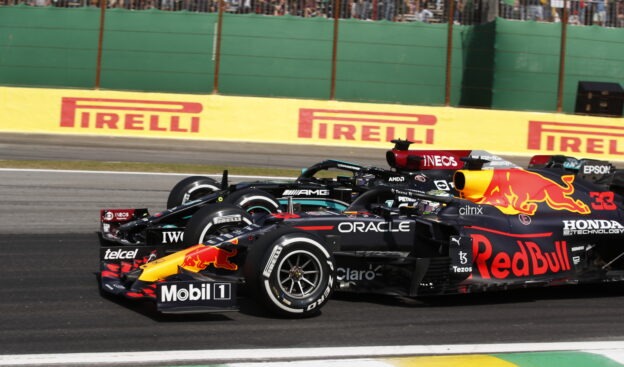Former F1 drivers back Verstappen before Thursday hearing

Nov.18 - Formula 1's governing body will hear Mercedes' arguments about a 'right of review' to challenge Max Verstappen's lack of penalty for his turn 4 move in Brazil.
A video hearing has been scheduled for Thursday 5pm in Qatar, with the Red Bull driver's newly-surfaced on-board video footage of his controversial defensive move against championship leader Lewis Hamilton as the centrepiece.
Red Bull team sources say they are "surprised" by Mercedes' push, but are otherwise yet to comment.
According to Bild newspaper, Dutchman Verstappen - whose championship lead dwindled to 14 points at Interlagos - could receive a grid penalty for Qatar.
A retrospective five-second penalty for Brazil is another possibility, which would drop him to third and further shrink his lead to just 11 points with three races to go.
"Of course there was no need to punish anyone for that (move)," former F1 driver Vitaly Petrov said.
"To defend his position, he braked as late as possible and it was clear that he wouldn't get into the corner normally."
Another former driver, Karun Chandhok, agrees.
He said Verstappen's was the "classic 'ease off the brake pedal and gently understeer wide' move".
"Every good racing driver on the planet would have done the same," said the Indian.
"Maybe Max deserved a warning but nothing more in my view. It was good, hard racing between two of the best drivers ever."
✅ Check out more posts with related topics:













False Advertising!
If you watch the onboard of Max's qualifying lap his steering wheel turns left to 90° at the apex of that corner at which point he's on the racing line so coming from the right hand side of the track.
On the lap in question his steering wheel turns left but to no where near 90° even though he's now on the left hand side of the track and would need a tighter line to make the corner and still leave one cars width as required by the sporting regs. Both videos available on official f1 website.
We frankly did not need the onboards because it was clear that Max out-braked himself and carried too much speed into the corner. Not only did he not leave a car's width for Lewis, but he also ran off the track himself and thereby gained a lasting advantage. Lando, Perez, et al, who have been penalized this year for not leaving a car's width in similar circumstances, all kept their cars within the track limits, but still got penalized. It was therefore shameful for the Stewards not to even bother to investigate the incidence.
All we are saying to the stewards is "be consistent" in the application of the rules and the fact that some drivers are competing for the WDC does not, in any way, invalidate the rules.
Let's be honest; for the stewards the main consideration in that moment would have been the consequences of spoiling the show.
Agreed and I think most people did not want a penalty to determine the outcome of the race.
However, in the interest of consistency and fairness, they could have stated that the incidence would be investigated after the race.
Sweeping it under the carpet like it never happened just gives rise to accusations of a conspiracy... just saying.
It's BAD ENOUGH that I have to endure David Croft's breathless on-the-verge-of-climax fawning over Hamilton and all things British ad nauseum. Of course, Brundle's justifying the God-like omniscience of Hamilton and his demi-God fellow Brits Norris and Russel is reporting at it's most pathetic, spit-roast worst.
But now we have to witness further erosion of this sport by a display of hubris by an unspeakably arrogant team - by Mercedes wanting to punish the only credible challenge to Hamilton to come along in years.
Isn't it enough that their chassis (a phenomenal engineering feat entirely responsible for winning the races), driven by a thoroughly average (I'm-so-woke-and-love-to-virtue-signal) driver, happened to win the race in Brazil? Oh, no. They feel obliged to try any feeble stratagem available to them to penalize Verstappen in their lust to crush the opposition and win at any cost.
It appears as though Hamilton and Mercedes somehow sense this is the beginning of the end to their dominance. So, they will sacrifice honor and respect in order to "win" through the back-door of a grid or time penalty.
As the result of the too-oft repeated and petulant snivels by Hamilton/Mercedes, the cache, the magical "je ne sais quoi", the essence of Formula 1, is further diminished.
Frankly, it's a bore watch Mercedes chassis' and their ho-hum passengers disappear over the horizon. Let's get back to honest racing and honest results. Without them, the Formula 1 sport is doomed.
Please, go and have a lie down before you hurt yourself....
Oh, Penelope, your droll sense of humor betrays you.
I like Canadians
Isn't it Christian Horner who is doing the most bleating? I think it is ironic that Mercedes have turned the tables on Red Bull and their previously illegal rear wings... which they weren't forced to change?
And as for the 0.2mm excess in a 85mm gap which they "apparently" found on Hamilton's rear wing, and which doesn't appear to be available for public scrutiny.... As a materials testing expert, I would say that you cannot measure to that accuracy without temperature controlled conditions! And it would take hours for a test sample of that size to stabilise at a set temperature. Also, the measuring equipment would exhibit greateer inaccuracies in real life due to ambient temperature fluctuations. So that finding, which resulted in Hamilton having to start the sprint from the back, is total nonsense and scientifically unsound.
you forgot to add ( In my opinion )
As Petrol Pete knows, metrology is a fairly large specialization. When measuring tenths of millimeters, the measuring device has to be capable of measuring in hundredths of millimeters.
As the Stewards are essentially conducting a Regulatory Audit, whose penalties can alter histories, I suggest that the "Go/No-Go" gauge is likely calibrated by an independent third-party metrology lab tied back to National Standards.
As the F1 chassis does not function in a climate-controlled environment, insisting on that as a prerequisite to accurate measurements to determine compliance is ludicrous, and you know it.
No, it is a scientific fact!
And, as CanadianEh says, the chassis is not in a temperature controlled environment, so making a judgement on 0.2mm is ludricous. Thanks for supporting my argument.
That is exactly the point I was making.... how can they make a judgement amounting to 0.2mm variation when they DON'T have stable conditions.
And, having once been a member of BSI, I can tell you that standards are not written in terms that cannot accurately be verified. And that is fact, too.
But good to get opinions flying about, even if they are pretty stupid!!!
Like it:-)
Well Mr. PP, your interpretation is entirely subjective, and for someone with experience in "standards", you ought to know better.
The 2021 F1 Technical regulations are clear about the taking of measurements. Specifically:
2.6 Measurements
All measurements must be made while the car is stationary on a flat horizontal surface.
Further, the specifications for the wing DRS opening are described. Specifically:
3.6.3 Rear wing profiles
Furthermore, the distance between adjacent sections at any longitudinal vertical plane must lie between 10mm and 15mm at their closest position, except, in accordance with Article 3.6.8, when this distance must lie between 10mm and 85mm when the DRS system is deployed.
So, I don't see a requirement for an environmental chamber at para 2.6. Nor do I see any + or - tolerances for the wing opening at para 3.6.3.
If you can find documentary evidence showing me that I'm mistaken, I'll be grateful for your input. In fact, I invite you to do just that.
CanadianEh..... This has completely gone over your head hasn't it?
Right, in simple terms:
If the car is sitting on a flat surface at 20 degrees, the gap will be x. If the same car is sitting on the same flat surface but the ambient temperature is 40 degrees, then the gap will be x + the expansion amount.
The gap would go up by 0.96mm, I have approximately calculated. So, say the gap was 84.90000 mm at 20 degrees, then it would be 85.86mm at 40 degrees. But they failed it for being 85.2mm.
So, what I am saying is that the gap will vary according to temperature. So, the specification should have quoted the measurement tolerances at a certain temperature or range of temperatures.
This effect (expansion) is also noticeable within an engine when you get piston slap when an engine is cold and the pistons then expand as the engine warms up and you get a better seal.
I can point you to any number of Materials Science books or university papers. But is is common knowledge within the materials science, engineering, physics and chemistry worlds. Materials expand and contract with temperature. It is why railway lines buckle in hot weather, ships' welds fail in artic seas.
Do you dispute that? (PetrolPete just rolls his eyes!)
Yes, you are right.... the FIA hasn't got a clue about writing materials performance standards. And, apparently, you too could do with going on a training day!
Just out of interest, (and I am a bit of a scientific Geek!), I have just completed some calculations on coefficients of expansion. Given the way that the wing assembly is built, the outer frame which holds the "top" wing is about twice the length of the actuating support of the lower "wing" (the one that moves)
This differential means that the gap will increase by 0.96mm if the temperature increases by 20 degrees. The testing device, if made of aluminium would increase in size by 0.04mm. This means that there is an increase in the gap of 0.92mm just because of increase in temperature of 20 degrees.
But the whole thing is further complicated by the fact Carbon fibre composites are bonded using different polymeric agents, which each have their own coefficients of expansion, and also the fact that the behaviour of the resulting laminate varies with orientation and the way the vertical struts are made. Carbon fibre (and GRP) are not isotropic. And to further compound the problems, their coefficients of expansion are not linear with absolute temperature. Dynamic mechanical, thermogravimetric and thermal analysis techniques show this.
And, of course, to confuse things even more there is the behaviour of polymers where they flow, and they also have a Glass Transition temperature where they "suddenly" become brittle. This latter behavioural issue can be induced by dropping temperature of testing, or increasing the speed of test/impact. For those interested, this is according to Boltzmann's Time Temperature super-position, which I proved whilst I was a Research Scientist. This is a fascinating subject and very pertinent to our engineering world.
In other words, it is a complete minefield, which is why, to punish someone for and apparently on-site measurement of 0.2mm is ludicrous and unsound.
✅ Checkout the latest 50 F1 Fans comments.